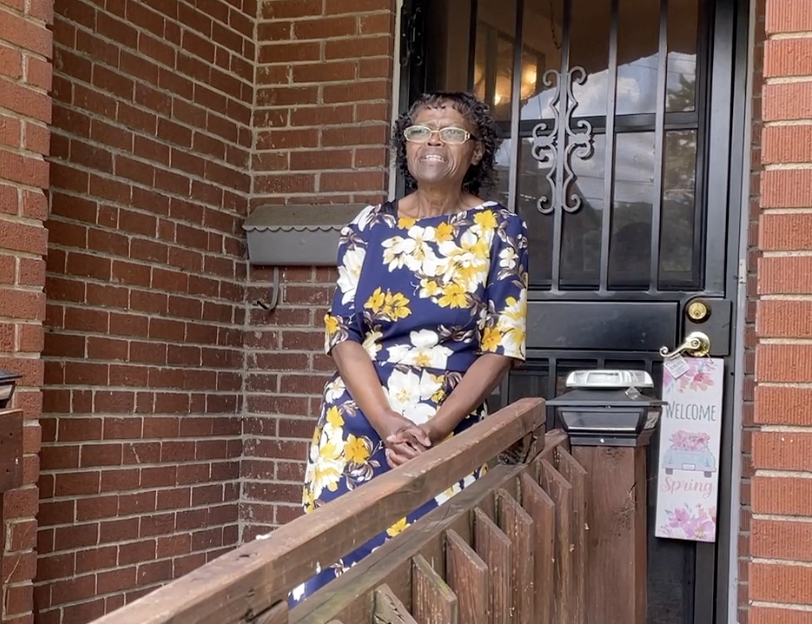CINCINNATI — Saundra Davis has lived for 30 years in a small home without central air conditioning in South Cumminsville, one of Cincinnati’s smallest — and hottest — neighborhoods.
It is known as an urban heat island, surrounded by empty warehouses, large parking lots, brownfields and industrial facilities. It's also very close to the traffic and pollution of Interstate 74.
“Yes, it is hotter here than in some areas of the city … and we really need bus shelters, even if it’s not a misting bus stop," Davis said.
As city leaders prepare for climate-change-induced hotter temperatures in the coming years, and summers that feel more like Arkansas than Ohio by 2030, mapping temperatures is becoming increasingly important.
“We see a 10- to 12-degree difference from one community to another,” said Ollie Kroner, Cincinnati’s sustainability manager. “Maybe that’s not a big deal if you have air conditioning at your house, but a third of Cincinnatians don’t. And so how do they find relief during a heat emergency?”
In August 2020, a team of volunteer street scientists drove and biked around the city taking temperatures at points along the way. It was part of a study funded by the National Oceanic and Atmospheric Administration to determine which neighborhoods were the hottest.
“They tend to align with the highways following the Mill Creek corridor and the downtown urban basin where we have more development, more pavement and less tree canopy,” Kroner said. “You might imagine on a hot sunny day if you’re under a tree in a cool breeze, it’s much cooler than if you’re in a parking lot surrounded by parking lots.”
The University of Cincinnati is launching a new study in August to collect temperature data in some of the city’s hottest neighborhoods — Lower Price Hill, South Cumminsville, Winton Hills, Corryville, Avondale, Bond Hill, and Over-the-Rhine, and contrast it with temperatures from cooler neighborhoods such as Mt. Airy and Westwood which have denser tree cover.
Pravin Bhiwapurkar, an associate professor at UC’s School of Architecture and Interior Design, studies urban heat islands and the impact of extreme heat.
“What we know is generally mostly low-income communities are affected by the extreme heat,” Bhiwapurkar said.
Often using a fan or opening a window can worsen their indoor air quality, he said.
“When it is really hot and humid outside and you use a fan, you are really bringing in that hot and humid air into your home, sometimes it really doesn’t help particularly if the outside temperature is about 95 degrees Fahrenheit with high humidity,” Bhiwapurkar said. “In Cincinnati … you also have a lot of pollutants that get trapped here, so you’re also bringing heat and air pollution sometimes by opening windows.”
In his 2016 study, Bhiwapurkar asked people who lived in South Cumminsville to install temperature and humidity sensors inside and outside of their homes, so he could gather data on the true impact of summer heat.
“I started recording air temperature as well as the air pollution … and realized that those communities are actually experiencing much higher air temperature compared to what we record or what we see from the local airport data,” Bhiwapurkar said.

Davis was a volunteer for his 2016 study. Realizing the true temperature inside her home, which often reached the low 90s in her upstairs bedroom, has had a lasting impact.
“When it’s hot like that I’m more mindful about when I do laundry, when I’m running the dryer and not using the oven unless I get a really deep craving for peach cobbler,” Davis said.
Now Bhiwapurkar is launching a much bigger study to gather the same heat data from more neighborhoods. He is looking for people who live in single-family homes without central air to install temperature sensors in their living rooms and outside in their yards or on utility poles.
The heat data he collects will help city leaders plan for the future.
“We do intentionally plant trees in areas that have less canopy,” Kroner said.
Davis was also part of a climate resiliency group that came up with ideas to help people who live in urban heat islands, such as rooftop and community gardens and bus shelters.
Because Davis is aware of the subtle impact of heat as she ages, she is planning on buying her first central air conditioning system next summer.
“As I age it’s more of a health issue with the heat,” said Davis. “Because global warming is real, and it is very dangerous. And going forward it will get even hotter.”
Note: Those interested in volunteering for the University of Cincinnati study on urban heat islands can contact Pravin Bhiwapurkar at: bhiwappn@ucmail.uc.edu He is looking for people who live in single family homes without central air conditioning, preferably without unit air conditioners, who would be willing to host the temperature and relative humidity sensors in their living rooms and outside in these neighborhoods: Lower Price Hill, South Cumminsville, Winton Hills, Corryville, Avondale, Bond Hill, Over-the-Rhine, Mt. Airy and Westwood.





